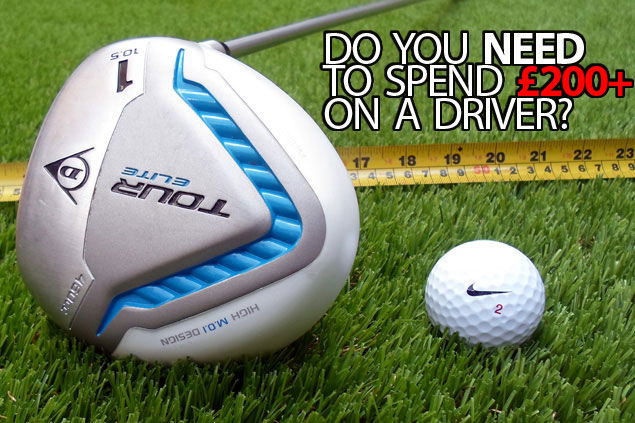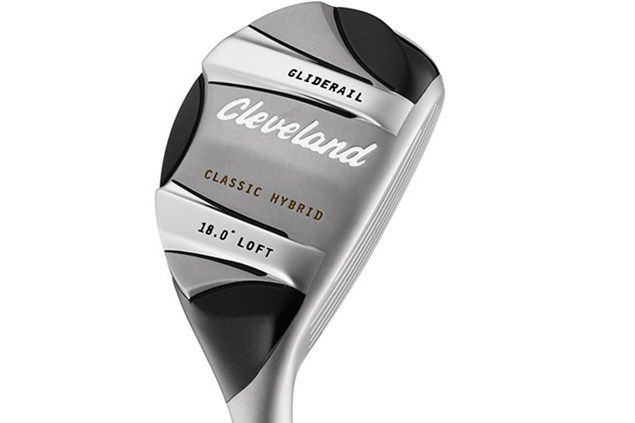�
Is a premium

Conclusion
Although this isn't exactly rocket science, there's a simple reason why Tour players, and better players, opt for top-of-the-range drivers from the likes of TaylorMade, Titleist, PING, Adams, Nike, Cleveland, Mizuno or Wilson.
Yes, staff players get paid tidy sums to play their sponsor's latest equipment, but at the same time, millions of dollar has been thrown into the research and development of the particular premium driver to improve its distance and feel.
The more affordable drivers, like the £17 Dunlop Tour Elite in this test, don't have that luxury. The expensive drivers also have much better weighted shafts in them which helps the player hit the ball further and straighter.
In terms of performance, the extra money placed in a premium driver will certainly give you maximum forgiveness from off-centre hits, torque and MOI (moment of inertia). With the R1, for example, you can effectively build your own driver with the help of a simple wrench supplied with the club.
When purchasing a more expensive driver, you typically have the option of testing multiple lofts, lie angles, lengths and shaft specifications, as well as custom fitting options with that particular brand. When purchasing a cheaper driver, you will usually be forced to use whatever the store has in stock. Such a club may not be suited to your unique swing speed and height.
Distance-wise, the Dunlop Tour Elite fell approximately 20 to 25 yards behind the R1, which isn't too bad when you come to think of the £273 price difference, and only a few yards on average behind it in the driving accuracy stakes.
If you've got the pennies to splash the cash on a premium driver, the benefits will become clear to see, especially with the new R1. Yet if you're a budget golfer who just wants to find the straight and narrow on a regular basis, and aren't too worried about the difference in feel and playing first into the green more often than not, the inexpensive Dunlop driver - less than the price of a green fee - is certainly the way forward.
Click on this link for our Game Improvement Drivers Club Test.
Results
OUTRIGHT DISTANCE
| Dunlop Tour Elite (Distance) | TaylorMade R1 (Distance) | Difference | |
| Andy (7) | 248 yards | 270 yards | 22 yards |
| Tom (pro) | 271 yards | 294 yards | 23 yards |
When it comes to distance, I drove the Dunlop Tour Elite 91.85% as far as the TaylorMade R1. Our pro, Tom, recorded a similar distance, driving the Dunlop Tour Elite 92.17% as far as the TaylorMade R1.
Hitting the Dunlop out the centre would still leave you needing an extra two or three clubs into the green, compared to the TaylorMade. Obviously the more club you use, the less control you're going to have. Would you feel comfortable using a 6-iron instead of a 9, or a 3-iron instead of a 6?
IN-DEPTH STATISTICS
R1 | Carry (yards) | Distance (yards) | Ball speed (mph) | Back spin (rpm) | Vertical launch (deg) | Offline distance (yards) |
Andy (7) | 243 | 270 | 145 | 2700 | 12 | 9 |
Tom (pro) | 272 | 294 | 149 | 2550 | 11 | 6 |
| Tour Elite | Carry (yards) | Distance (yards) | Ball speed (mph) | Back spin (rpm) | Vertical launch (deg) | Offline distance (yards) |
Andy (7) | 220 | 248 | 140 | 3130 | 13 | 14 |
Tom (pro) | 249 | 271 | 145 | 2790 | 10 | 10 |
Analysis
From our results, you can see the £17 Dunlop Tour Elite fell approximately 20 yards on average behind the £300 R1 in the distance stakes, which is astonishing given the £283 price difference.
It also matched the R1 well in terms of accuracy, with an average difference in offline distance of around five yards.
Yes, the R1 is a much more forgiving driver but given its £17 price-tag, we didn't expect the Dunlop to be capable of getting the ball over 90% as far as the TaylorMade R1.
Launch angle with the Dunlop was, as expected, much lower due to the less stable Graffaloy shaft, and while we weren't that impressed with the sound at impact, the more worrying feature was the lack of feedback when striking the ball.
With all due respect to the budget golfer playing once every few weeks, or the higher capper who just wants to give the ball a swipe off the tee, do all these 'feel' and 'sound' characteristics really matter? Probably not.
Appearance wise, the Tour Elite is very bland looking in comparison to the R1, but again, there are expensive drivers out there that don't look that great either. The Dunlop at least tries to look sharp and we give it credit for that.
Verdict
The headline figures from our test state that TaylorMade's R1 gives you a distance advantage of just under 10% over the Dunlop Tour Elite.
However, what our test can't scientifically measure is the feel, sound and appearance. The R1 really excels when it comes to feel and playability. The R1's standard RIP Phenom 55g shaft is incredibly light but promotes much faster clubhead speed while delivering greater feel throughout the swing.
Sound at impact is also much more appealing with the R1, given you can feel the difference in strike and sound when hitting one out the sweetspot. With the Dunlop, strikes out the centre and heel or toe sound similar. The TM 360 grip in the R1 is another nice touch as it ensures a firm grasp of the club, in comparison to the thin Dunlop Gecko-Tac grip.
If the higher capper has got the pennies to splash the cash on a premium driver then they won't be disappointed with bagging the TaylorMade R1, particularly with all the adjustability on offer at the touch of a wrench.
However, we say buy the £17 Dunlop, fit a decent grip and for under £30 you've got a driver that will do the basics very well.
While there's no doubt we'd favour the TaylorMade R1 if it were a choice of playing either of these drivers, there's no question the budget golfer is better suited to the Dunlop Tour Elite and spending the remainder of the money on improving their game through lessons with a PGA pro.
Once that golfer has improved his or her swing mechanics, only then would we recommend making the upgrade to the R1 or any other premium driver.


